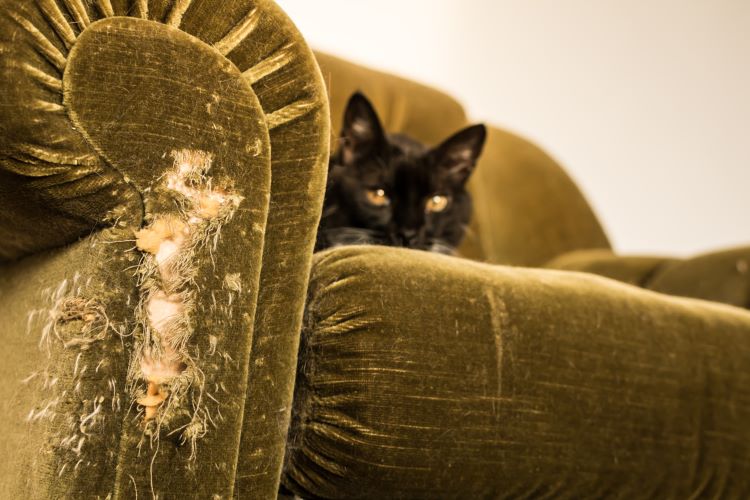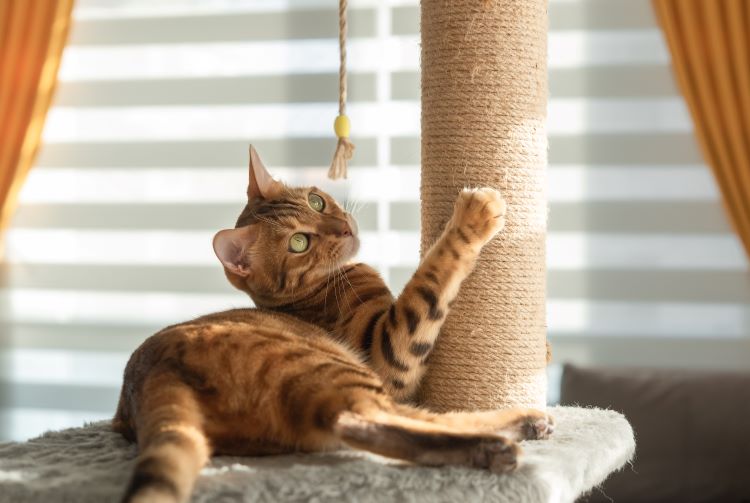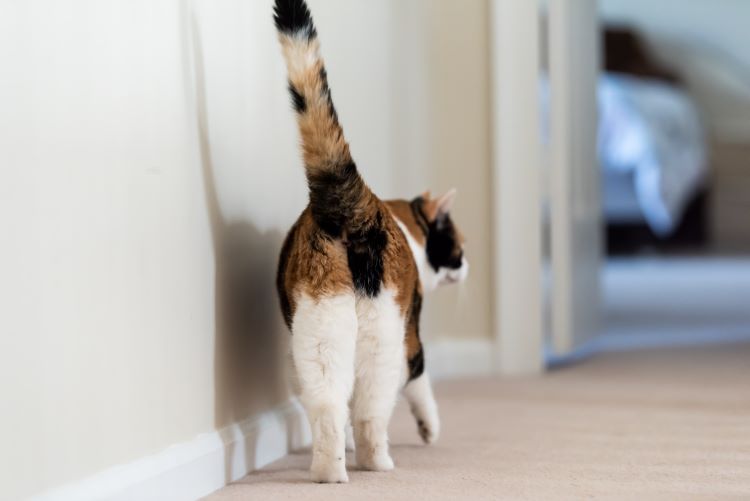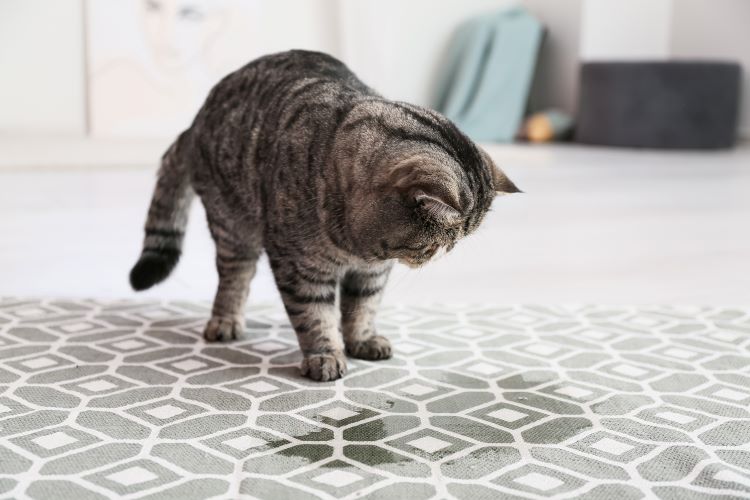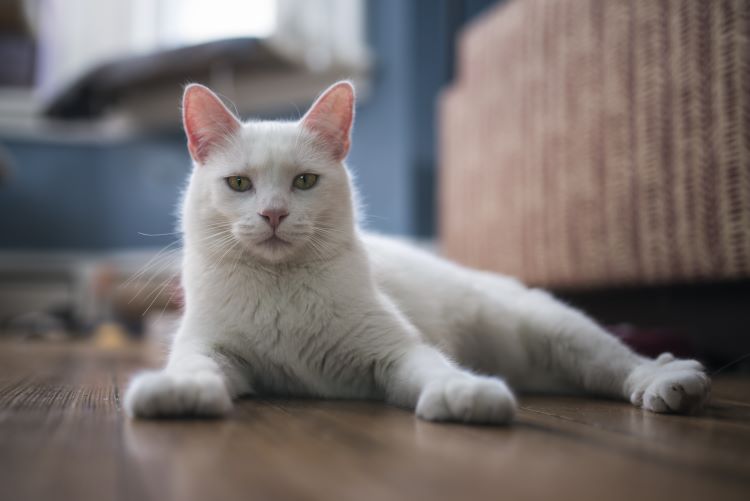
They may be small and furry and really, really cute, but cats can do a lot of damage to your furniture and décor. With their sharp claws, they can ruin the fabric on a chair, couch, or pillow. Those claws can rip up carpet, too, or shred curtains. And then there’s the spraying—on furniture, on floors, on possessions or plants. Cats can ruin surfaces by urinating on them, too.
Sometimes, your furniture or carpet is beyond saving, and that’s when you can call Space Makers Junk Removal to haul them off.
However, if you know why cats are being destructive, you can take measures to prevent damage in the first place. Cat-proofing your belongings starts with understanding cat behavior and ruling out health issues, then setting up your space so cats aren’t tempted to be destructive.
WHY IS MY CAT SCRATCHING MY FURNITURE?
Your cat isn’t intentionally being “bad.” Instead, he’s doing what his instincts are telling him to do. Outdoors, cats scratch surfaces like tree trunks for three reasons, according to petMD.
First, clawing sloughs off the old, outer sheath of their nails so the new, sharp nail emerges. And sharp nails are essential for hunting, fighting, and climbing.
Second, when cats claw trees, glands in their feet release a pheromone that signals “this is my territory!” The pheromones also telegraph information to other cats: how healthy they are, whether they’re male or female, and whether they’re “available” for mating.
Third, cats scratch because it feels good; as they scratch, cats elongate their backs, relieving tension in their muscles. At the same time, their brains release chemicals that aid them in calming down.
Indoors, cats turn to vertical surfaces like couches and table legs as substitutes for tree trunks. If you have multiple cats in the house or you introduce a new cat, your cat may scratch up your couch to establish territory, take out anxiety, or get those nails ready to scrap with the competition.
WHY IS MY CAT SCRATCHING MY CARPET?
Carpet is attractive to cats because it’s a stable, soft surface and easy to scratch.
HOW CAN I MAKE MY CAT STOP SCRATCHING MY FURNITURE AND CARPET?
GIVE YOUR CAT SOMETHING ELSE TO SCRATCH
Try offering your cat satisfying alternatives to your couch legs, like a quality scratching post.
It needs to be sturdy enough not to fall over, tall enough so your cat can stretch out as she scratches, and made from materials your cat prefers (rope, carpet, cardboard, wood). If your cat loves to sink her claws into your sisal rug, for example, then a scratching post covered in sisal might work best. For cats that tend to scratch up the carpet or other flooring, a scratching board will likely work best. Choosing the right material may take some trial and error.
CHOOSE THE RIGHT SPOT FOR A SCRATCHING POST
If your cat always goes after your couch, then put the scratching post or board near the couch—or any other place your cat tends to sharpen his claws. If that doesn’t work, try placing the post near where the cat likes to sleep or eat, or place it near a litter box. Place several posts or boards around the house to give your cat plenty of options.
HELP YOUR CAT LEARN TO USE A SCRATCHING POST
Sprinkle catnip on the post to attract your cat to it. If your cat seems interested, scratch at the post yourself, signaling to your cat that this surface is okay to scratch up. When you see your cat using the post, praise him, pet him, or offer a treat to reinforce the behavior.
DISCOURAGE YOUR CAT FROM SCRATCHING THE CARPET AND FURNITURE
To discourage a cat from scratching up your belongings, you need to make them unattractive to the cat.
SPRAY SURFACES WITH A SCENT CATS HATE
Make your couch legs unappealing to your cat by making them smell bad—at least to your cat.
According to Cats.com, there are many scents that cats dislike or that are toxic to them: citrus, vinegar, eucalyptus, bananas, mint, menthol, coffee, pepper, mustard, chili, and most household products. Many cats also dislike the smell of lavender and other herbs, like rosemary.
To make your furniture or carpet unappealing to your cat, try spraying surfaces with a lemon-, orange-, or lavender-based spray that’s safe for fabric (test a patch first!). Make a spray by combining one part apple cider vinegar and one part water to spray on surfaces (again, test a patch before doing this!).
SPRAY SURFACES WITH A PHEROMONE SPRAY
When cats rub their faces against your chair or coffee table, they’re leaving behind a feline hormone to mark the spot. Cats don't usually scratch where they've deposited this hormone, so if you spray pheromones on a place where cats tend to scratch, they will leave it alone.
MAKE SURFACES UNAPPEALING TO YOUR CAT
According the ASPCA, cats dislike certain surfaces, such as sticky or plastic ones, and they’ll avoid them. Try covering your couch or carpet with double-sided sticky tape, sticky paper, sandpaper, a plastic cover, or a plastic carpet runner with knobby side up. Cats don’t like aluminum, either, so cover small areas in foil to deter cats. Once you’ve trained you cat to use a scratching post, you can remove these deterrents.
If you want to go more hardcore, you can buy a product like Sticky Paws Pioneer Pet Roll as a solution.
WHY IS MY CAT SPRAYING MY CARPET AND FURNITURE?
Spraying is a form of marking that occurs when a cat backs up to a surface and shoots or sprays that surface with hormone-laced urine that has a strong smell. According to petMD, the chief reason cats spray is to establish the boundaries of their turf. In a house with multiple cats, one may be claiming a certain area, a particular litter box, a toy, or other items. Cats spray outside to mark turf, but indoor cats will mark turf when they sense an outdoor cat is a threat. In addition, a cat sprays to signal that he or she is interested in mating. Cats also spray when they’re stressed out by something, like a change of routine, visitors, a new pet, or loud noises.
HOW CAN I MAKE SPRAYING STOP?
There are several ways to get a cat to stop spraying your belongings.
ELIMINATE HEALTH ISSUES
Take your cat to the vet to have him checked out for underlying medical conditions, like kidney disease or a urinary tract infection.
GET YOUR CAT SPAYED OR NEUTERED
Cats that have been “altered” are less likely to feel the need to spray.
INTRODUCE A NEW PET OR OTHER CHANGES SLOWLY
If you’re bringing a new cat or kitten into your home, don’t just plunk the newcomer down and expect your cat to welcome him or her. You should introduce the cats to one another very slowly. Follow the steps provided by the Humane Society to make sure the introduction is successful.
Introducing a new dog to your cat follows much the same process, with a few differences. American Humane offers a great fact sheet with steps for a successful introduction.
USE MULTIPLE LITTER BOXES
You should have a litter box for every cat, plus an extra one, each placed in a different part of your home.
GIVE EACH CAT A SEPARATE BED, BOWL, AND PERCH
Cats often don’t share well. Make sure each cat in your household has his or her own food bowl, dining area, scratching post, bed, and perch.
KEEP OTHER CATS OUT OF YOUR YARD
Neighborhood and stray cats who deposit their scents on your porches, patio furniture, and other outdoor objects can stress out your cat and lead to spraying. Reduce the stress by blocking an indoor cat’s view of outdoor cats by covering windows. Don’t leave food outdoors that might attract neighborhood cats. Discourage outdoor cats from coming into your yard by deploying motion-activated sprinklers, sound devices, and cat repellents that you spray on bushes, fences, patio furniture, etc.
WHY IS MY CAT CLIMBING THE CURTAINS?
Just like with scratching and marking, climbing is natural for cats. Outdoors, they need that skill to escape predators on the ground, to spot prey, or to be able to look around. Plus, it’s fun to scamper up a tree or over a fence. So if your cat is climbing your curtains, he’s just practicing that skill.
Stress may also be driving you cat to shimmy up your curtains as a way to get away from people, children, or other pets. Cats who don’t get enough stimulus indoors will also climb because they’re bored.
HOW DO I MAKE MY CAT QUIT CLIMBING THE CURTAINS?
GIVE YOUR CAT A LIFT
The best way to discourage your cat from climbing up your window treatments is to provide the cat with a tempting alternative, such as a cat perch, a cat tree, a hammock, or a cat tower. Each of these provides a fun way for your cat to get up high—which cats love—and to keep entertained.
KEEP YOUR CAT ENTERTAINED
Bored cats think curtain climbing is fun, so offer your cat something else fun to do, like a puzzle box with toys or treats inside, or several other cat toys, like feathers on sticks, balled-up socks, catnip-filled soft toys, etc. Reward them when they play with these objects. Kittens in particular need a lot of interaction and stimulus, and they need to be rewarded when they play with the right objects.
KEEP CURTAINS PULLED BACK
Tie back curtains so they’re not easy to climb or they don’t present themselves as something easy to climb.
WHY IS MY CAT PEEING IN THE HOUSE INSTEAD OF USING A LITTER BOX?
Just like with spraying, your cat may have several reasons for peeing on flooring, furniture, linens, and other items.
- Always rule out health issues first by taking your pet to the vet to check for illness, disease, or arthritis. Any of those problems could make it difficult for your cat to use a litter box or tell you in time that he needs outside.
- If health issues aren’t the cause, consider behavioral issues next. Maybe your cat prefers a very clean litter box and you need to scoop it more often. Maybe something about where the littler box is located upsets your cat. For example, if it’s near a door where an outside dog can peer in, your cat might be afraid to use the litter box there. If you have more than one cat, each one needs his or her own litter box. If that’s not happening, then one cat may be using the carpet instead of going where another cat has gone. Careful observation and trial-and-error will help you figure out why your cat is behaving as she is.
- Your cat may also be peeing on things becaus she did so before, whether by accident or on purpose. And since cats tend to revisit those spots to pee again, that may be why your cat keeps peeing on your living room rug or favorite pillow. If the urine isn’t cleaned up properly, you’re inviting your cat to go there again.
HOW CAN I GET THE URINE SMELL OUT AFTER MY CAT HAS PEED OR SPRAYED?
ACT FAST
Let’s face it: cat pee is an awful smell, and it is not easy to eliminate. In fact, the longer urine sits on a surface, the worse the smell becomes. That’s because the urine contains bacteria that multiply, making the odor worse. Acting fast is your best bet for getting rid of the smell in carpet, cushions, mattresses, and furniture.
- Blot or soak up as much urine as possible with a cloth.
- Rinse the spot with water, then use a wet-vac to suck up the water. (Don’t use a steam cleaner because the heat will set the stain.) For pillows, soak the stained area in water, then blot as dry as possible.
- Apply an enzyme-based cleaner to the area, following the manufacturer’s instructions. Usually, you will soak the stained area, let it sit for the recommended time, then blot the area with towels.
- Let the area dry thoroughly, then reapply the cleaner if needed.
I CLEANED MY CARPET, SO WHY DOES IT STILL SMELL?
When a cat pees on flooring, the urine can soak through to the subfloor. Even though you clean the floor or carpet, the odor can linger in the carpet pad or subfloor. In that case, you will need to pull up the carpet, remove the pad and replace it with a new one, and apply an enzyme-based cleaner to the subfloor. You may also need to replace the carpet in the affected area.


